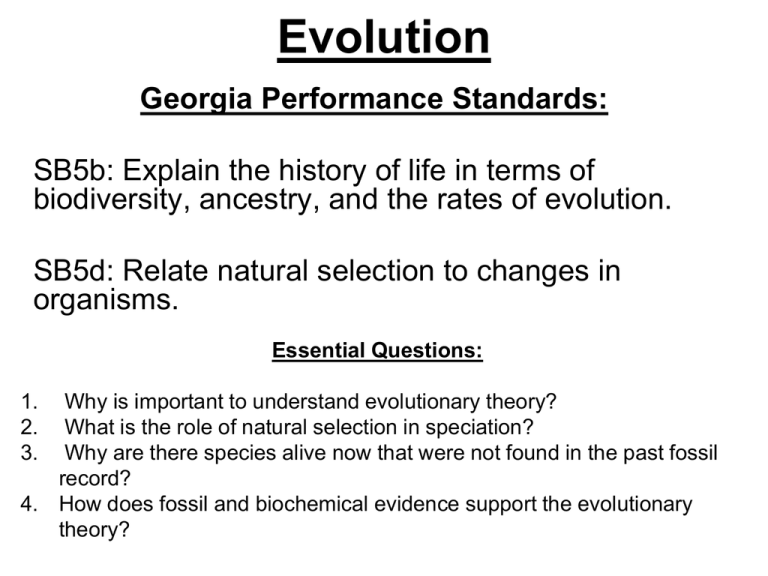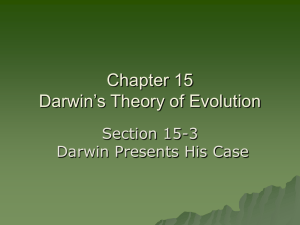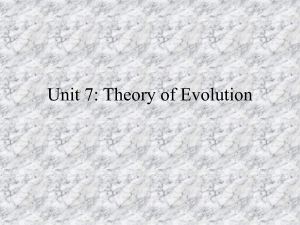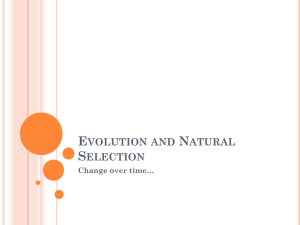Evolution
advertisement

Evolution Georgia Performance Standards: SB5b: Explain the history of life in terms of biodiversity, ancestry, and the rates of evolution. SB5d: Relate natural selection to changes in organisms. Essential Questions: 1. 2. 3. Why is important to understand evolutionary theory? What is the role of natural selection in speciation? Why are there species alive now that were not found in the past fossil record? 4. How does fossil and biochemical evidence support the evolutionary theory? What scientific explanation can account for the diversity of life? • Answer: The evolutionary theory • Evolution, or change over time, is the process by which modern organisms have descended from ancient organisms. • A theory is a well-supported testable explanation of phenomena that have occurred in the natural world. Charles Darwin • During his travels, Darwin made numerous observations and collected evidence that led him to propose a revolutionary hypothesis about the way life changes over time. • That hypothesis, now supported by a huge body of evidence, has become the theory of evolution. Darwin’s Observations: • Patterns of Diversity - the many ways in which organisms survived and produced offspring. • Living Organisms and Fossils - Why had so many of these species disappeared? How were they related to living species? • The Galápagos Islands - The higher islands had greater rainfall and a different assortment of plants and animals Giant Tortoises of the Galápagos Section 15-1 Islands Pinta Pinta Island Tower Marchena Intermediate shell Fernandina James Santa Cruz Isabela Santa Fe Hood Island Floreana Isabela Island Dome-shaped shell Hood Saddle-backed shell Ideas That Shaped Darwin's Thinking • Hutton’s Theory of Geological Change – proposed that Earth had to be much more than a few thousand years old. • Lyell’s Principles of Geology – Lyell’s work explained how awesome geological features could be built up or torn down over long periods of time. – Lyell helped Darwin appreciate the significance of geological phenomena that he had observed. Ideas That Shaped Darwin's Thinking • This understanding of geology influenced Darwin in two ways. 1. If Earth could change over time, might life change as well? 2. Darwin realized that it would have taken many, many years for life to change in the way he suggested. Ideas that shaped Darwin’s Thinking: • Lamarck proposed that by selective use or disuse of organs, organisms acquired or lost certain traits during their lifetime. – These traits could then be passed on to their offspring. – Over time, this process led to change in a species. – Lamarck’s ideas were incorrect in several ways (he did not know how traits are inherited) – He did not know that an organism’s behavior has no effect on its inheritable characteristics. – Lamarck was one of the first to develop a scientific theory of evolution and realize that organisms are adapted to their environments. – He paved the way for the work of later biologists. Ideas that Shaped Darwin’s Thinking • Malthus & Population Growth reasoned that if the human population continued to grow unchecked, sooner or later there would be insufficient living space and food for everyone. Checkpoint Questions: 1. What two ideas from geology were important to Darwin’s thinking? 2. According to Lamarck, how did organisms acquire traits? 3. According to Malthus, what factors limited population growth? 4. Why has Lamarck’s theory of evolution been rejected? 5. Malthus formed his theory by studying factors that control the population growth of humans. How might factors operating on organisms in nature differ from those of Malthus’s theory? Darwin’s Conclusions: • On the Origin of Species. – In his book, he proposed a mechanism for evolution that he called natural selection. – He then presented evidence demonstrating that the process of evolution has been taking place for millions of years—and continues in all living things. Darwin’s Conclusions: • Natural variation, defined as differences among individuals of a species, is found in all types of organisms. Variation is present in species in nature • Artificial selection, nature provided the variation among different organisms, and humans selected those variations that they found useful. Darwin’s Conclusions: • Evolution by Natural Selection – struggle for existence means that members of each species compete regularly to obtain food, living space, and other necessities of life. – The ability of an individual to survive and reproduce in its specific environment fitness, which is the result of adaptations. – An adaptation is any inherited characteristic that increases an organism’s chance of survival. – Successful adaptations enable organisms to become better suited to their environment and thus better able to survive and reproduce Darwin’s Conclusions: • Individuals that are better suited to their environment—that is, with high levels of fitness— survive and reproduce most successfully. • This was a process that Darwin called survival of the fittest. • Because of its similarities to artificial selection, Darwin referred to the survival of the fittest as natural selection. – In both artificial selection and natural variation, only certain individuals of a population produce new individuals Darwin’s Conclusions: • Over time, natural selection results in changes in the inherited characteristics of a population. • These changes increase a species’ fitness in its environment. – Natural selection cannot be seen directly; it can only be observed as changes in a population over many successive generations. Descent With Modification • Natural selection produces organisms that have different structures, establish different niches, or occupy different habitats. • As a result, species today look different from their ancestors. • Each living species has descended, with changes, from other species over time. • If we look far enough back, the logic concludes, we could find the common ancestors of all living things. This is the principle known as common descent. Evidence of Evolution: • Fossil record - by examining fossils from sequential layers of rock, one could view how a species had changed and produced different species over time, as shown in the figure at right. • Geographical distribution of living species • Biochemistry • Similarities in Embryonic Development • Homologous structures of living organisms – structures that have different mature forms in different organisms but develop from the same embryonic tissues – Not all homologous structures serve important functions. – Vestigial organs (the organs of many animals are so reduced in size that they are just vestiges, or traces, of homologous organs in other species. Homologous Body Structures Section 15-3 Turtle Alligator Bird Typical primitive fish Mammals Concept Map Section 15-3 Evidence of Evolution includes The fossil record Geographic distribution of living species Homologous body structures Similarities in early development which is composed of which indicates which implies which implies Physical remains of organisms Common ancestral species Similar genes Similar genes Summary of Darwin’s Theory • • • • Individual organisms in nature differ from one another. Some of this variation is inherited. Organisms in nature produce more offspring than can survive, and many of those that survive do not reproduce. Because more organisms are produced than can survive, members of each species must compete for limited resources. Because each organism is unique, each has different advantages and disadvantages in the struggle for existence. Summary of Darwin’s Theory • Individuals best suited to their environment survive and reproduce most successfully. The characteristics that make them best suited to their environment are passed on to offspring. Individuals whose characteristics are not as well suited to their environment die or leave fewer offspring. • Species change over time. Over long periods, natural selection causes changes in the characteristics of a species, such as in size and form. New species arise, and other species disappear. • Species alive today have descended with modifications from species that lived in the past. • All organisms on Earth are united into a single tree of life by common descent. Checkpoint Questions: 1. How is artificial selection dependent on variation in nature? 2. The theory of evolution by natural selection explains, in scientific terms, how living things evolve over time. What is being selected in this process? 3. What types of evidence did Darwin use to support his theory of change over time? 4. What is the “struggle for existence”? How was this idea based on Malthus’s work? 5. Compare and contrast Darwin’s theory of evolution with that of Lamarck. How are they similar? How are they different? Patterns of Evolution • Macroevolution refers to the large-scale evolutionary changes that take place over long periods of time. • Six important patterns of macroevolution – – – – – – mass extinctions adaptive radiation convergent evolution Coevolution punctuated equilibrium changes in developmental genes. Mass Extinctions: • New fossil studies show that those mass extinctions not only extinguished species but also wiped out whole ecological systems, disrupting energy flow throughout the biosphere and causing food webs to collapse. • Many paleontologists think that most mass extinctions were caused by multiple factors. • For the survivors, there was a new world of ecological opportunity. • Often, the result was a burst of evolution that produced an abundance of new species. Adaptive Radiation • Studies of fossils or of living organisms can show that a single species or a small group of species has evolved into several different forms that live in different ways. • This process is known as adaptive radiation. – Implies common descent Convergent Evolution • Unrelated organisms that come to resemble one another, is called convergent evolution. • Natural selection may mold different body structures, such as arms and legs, into modified forms, such as wings or flippers. – EX: Streamlined body of penguin, shark, dolphin Coevolution • The process by which two species evolve in response to changes in each other over time is called coevolution. • An evolutionary change in one organism may also be followed by a corresponding change in another organism. • EX: Many flowering plants, for example, can reproduce only if the shape, color, and odor of their flowers attract a specific type of pollinator. Punctuated Equilibrium • Evolution has often proceeded at different rates for different organisms at different times during the long history of life on Earth. (Rate of Evolution) • Gradualism - slow, steady change in a particular line of descent. • Punctuated equilibrium - long, stable periods interrupted by brief periods of more rapid change Developmental Genes and Body Plans • First, molecular studies show that homologous hox genes establish body plans in animals as different as insects and humans • Second, major evolutionary changes—such as the different numbers of wings, legs, and body segments in insects—may be based on hox genes. • Finally, geneticists are learning that even small changes in the timing of genetic control during embryonic development can make the difference between long legs and short ones Changes in developmental genes are one major pattern of macroevolution. • Fossil evidence shows that some ancient insects (top left) had no wings, but others (top right) had winglike structures on many body segments. • In modern insects (bottom), genes may turn off wing development in all except one or two body segments. Checkpoint Questions: • What is macroevolution? Describe two patterns of macroevolution. • What role have mass extinctions played in the history of life? • Use an example to explain the concept of coevolution. • How might hox genes contribute to variation? • Compare and contrast the theories of gradualism and punctuated equilibrium.









